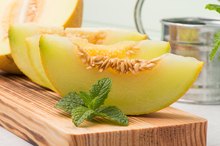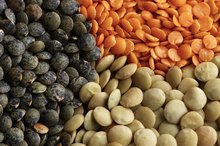What does fact checked mean?
At Healthfully, we strive to deliver objective content that is accurate and up-to-date. Our team periodically reviews articles in order to ensure content quality. The sources cited below consist of evidence from peer-reviewed journals, prominent medical organizations, academic associations, and government data.
The information contained on this site is for informational purposes only, and should not be used as a substitute for the advice of a professional health care provider. Please check with the appropriate physician regarding health questions and concerns. Although we strive to deliver accurate and up-to-date information, no guarantee to that effect is made.
How to Count Dietary Fiber Carbs on a Low-Carb Diet
The more fiber you eat on your low-carb diet, the better. Not only does fiber offer important health benefits, but the grams of fiber you eat daily get subtracted from your overall carbohydrate intake -- they’re “free” carbs. All plant foods supply fiber, but some are richer in fiber while being low in overall carbohydrate. These should take precedence in your low-carb plan.
Low-Carb Facts
The amount of carbohydrate you consume depends on the way you design your low-carb diet – whether you follow a trusted plan or just do it yourself 1. Technically, any diet in which you take in fewer than 130 grams of carbs a day is “low carb,” because that’s the amount set as the adequate intake for adults by the National Academies of Science. The NAS actually recommends much higher levels to prevent deficiency and chronic disease – 45 to 65 percent of daily calories on a 2,000-calorie diet, which would equal 225 to 325 grams of carbs a day.
Low-carb plans set different recommendations. Atkins, the classic low-carb diet, limits you to just 20 grams of “net carbs” a day for at least two weeks, then increases your consumption until you’ve reached 100 daily grams 1. You calculate net carbs by taking the overall grams of carbohydrate in a food and subtracting the grams of fiber and sugar alcohols – two types of carbs that are indigestible by the body and have no effect on blood sugar.
- The amount of carbohydrate you consume depends on the way you design your low-carb diet – whether you follow a trusted plan or just do it yourself 1.
- The NAS actually recommends much higher levels to prevent deficiency and chronic disease – 45 to 65 percent of daily calories on a 2,000-calorie diet, which would equal 225 to 325 grams of carbs a day.
The Importance of Fiber
List of Roughage Foods
Learn More
When you concentrate on high-protein meat in your low-carb diet, you have to be careful to get enough fiber, because only plant foods furnish this nutrient. Fiber has numerous benefits, including helping to manage blood sugar and cholesterol levels and aiding digestion and regular bowel movements. It may also reduce your risk of diseases such as diabetes, heart disease and diverticulitis. You need 20 to 30 grams of fiber daily for overall good health, but many Americans get only half that much.
- When you concentrate on high-protein meat in your low-carb diet, you have to be careful to get enough fiber, because only plant foods furnish this nutrient.
- Fiber has numerous benefits, including helping to manage blood sugar and cholesterol levels and aiding digestion and regular bowel movements.
Counting Dietary Fiber Carbs
In the first phase of a low-carb diet like Atkins, you primarily eat carbs from non-starchy vegetables 1. These foods have the lowest net carbs because they have overall low carb counts plus more fiber. In later phases of Atkins and other diets, you graduate to fruits, grains, legumes, nuts and starchy vegetables, which also have considerable fiber but are higher in overall carbs.
To count the dietary fiber in fresh foods like vegetables, you’ll need to use a nutrient database like the USDA, which gives you total carb and fiber counts for thousands of foods, or another database based on the USDA's numbers 34. For packaged foods like grains or beans, you can consult the nutrient panel, look for fiber under total carbs and deduct the grams of fiber from grams of carbs. The nutrient panel also gives you the serving size. So, if a food has 10 grams of carbs in a 1/4-cup serving but 3 grams of fiber, the net carbs would be 7 grams.
If you’re following Atkins, take advantage of its carb counter tool that does your work for you, listing the most common foods with their serving sizes and net carb counts. The counter is available online or as an app for your phone or tablet.
- In the first phase of a low-carb diet like Atkins, you primarily eat carbs from non-starchy vegetables 1.
- To count the dietary fiber in fresh foods like vegetables, you’ll need to use a nutrient database like the USDA, which gives you total carb and fiber counts for thousands of foods, or another database based on the USDA's numbers 3.
Differences in Fiber and Carb Counts
Oatmeal in a Low-Carb Diet
Learn More
Your best bets for carbs are non-starchy vegetables, which are good sources of fiber while providing relatively few carbs overall. For example, cooked turnip greens offer 6 grams of total carbs in a cup with 5 grams of fiber, for a net carb count of just 1 gram. A cup of cooked cauliflower has 6 grams of carbs and 3 grams of fiber, for 3 grams of net carbs.
While a starchy veggie like sweet potato offers a lot of fiber – 8 grams in a cup of mashed – it also provides 58 grams of carbs, so the total net carb count is a whopping 50 grams. That could be more than your carb allotment for the day.
Fruits tend to be both high in fiber and higher in overall carbs. A cup of raw raspberries provides a hefty 8 grams of fiber with 15 grams of overall carbs, for a net carb count of 7 grams. In contrast, a cup of raw blueberries may have 4 grams of fiber, but it also supplies 21 grams of total carbs, for a net carb count of 17 grams. A dried fruit like raisins has significant fiber – 11 grams in 1 cup packed – but a jaw-dropping 129 grams of carbs, bringing your net carbs to 118 grams in a cup.
- Your best bets for carbs are non-starchy vegetables, which are good sources of fiber while providing relatively few carbs overall.
- While a starchy veggie like sweet potato offers a lot of fiber – 8 grams in a cup of mashed – it also provides 58 grams of carbs, so the total net carb count is a whopping 50 grams.
Related Articles
References
- Atkins: Atkins 20 Diet Plan
- T.H. Chan Harvard School of Public Health: Fiber
- USDA Nutrient Database: Vegetables: Fiber and Carbohydrate
- USDA Nutrient Database: Fruits: Fiber and Carbohydrate
- Full article: Changes in dietary fiber intake in mice reveal associations between colonic mucin O-glycosylation and specific gut bacteria
- Fiber
- Fiber
- Closing America’s Fiber Intake Gap
- Meta-Analysis of Usefulness of Psyllium Fiber as Adjuvant Antilipid Therapy to Enhance Cholesterol Lowering Efficacy of Statins - ScienceDirect
- Fiber
- Fiber
- New Horizons for the Study of Dietary Fiber and Health: A Review | SpringerLink
- FoodData Central
- Error
- FoodData Central
- Error
- None
- FoodData Central
- Error
- None
- FoodData Central
- Acute Effects of Nitrate-Rich Beetroot Juice on Blood Pressure, Hemostasis and Vascular Inflammation Markers in Healthy Older Adults: A Randomized, Placebo-Controlled Crossover Study - PubMed
- FoodData Central
- None
- FoodData Central
- None
- FoodData Central
- FoodData Central
- FoodData Central
- FoodData Central
- None
- FoodData Central
- Error
- Error
- FoodData Central
- Error
- FoodData Central
- FoodData Central
- Effect of Oat β-Glucan Intake on Glycaemic Control and Insulin Sensitivity of Diabetic Patients: A Meta-Analysis of Randomized Controlled Trials - PubMed
- Error
- FoodData Central
- FoodData Central
- FoodData Central
- None
- FoodData Central
- FoodData Central
- None
- None
- FoodData Central
- None
Resources
Writer Bio
Paula Martinac holds a Master of Science in health and nutrition education from Hawthorn University, with an emphasis on healthy aging, cancer prevention, weight control and stress management. She is Board Certified in holistic nutrition and a Certified Food and Spirit Practitioner, and has written extensively on nutrition for various websites.









